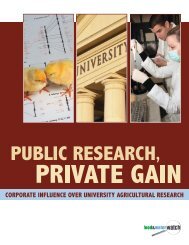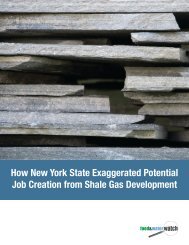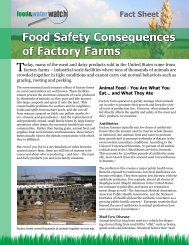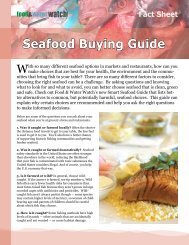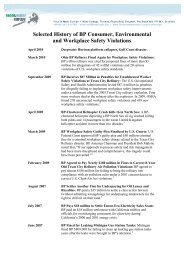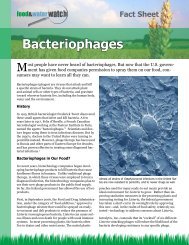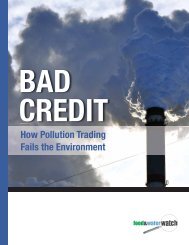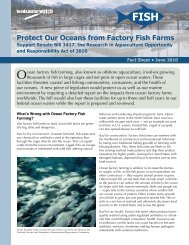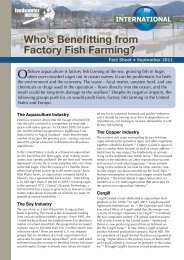Monsanto - Food & Water Watch
Monsanto - Food & Water Watch
Monsanto - Food & Water Watch
Create successful ePaper yourself
Turn your PDF publications into a flip-book with our unique Google optimized e-Paper software.
After a period focused on agrichemicals — including<br />
production of the notorious Agent Orange (see sidebar)<br />
and production of PCBs, a class of chemicals so toxic that<br />
they were banned in the 1970s but still pollute the environment<br />
today — <strong>Monsanto</strong> transitioned beyond chemicals<br />
into seeds. After its creation of an agricultural division<br />
in 1960, <strong>Monsanto</strong> went on a buying spree for the next<br />
40 years, acquiring and merging with dozens of seed and<br />
agricultural companies (and shedding its chemical and<br />
industrial divisions) to broaden its operations once again<br />
and shift itself exclusively into the agricultural market. 17<br />
See Figure 1 on pages 6–7 for a timeline of <strong>Monsanto</strong>’s<br />
history.<br />
Modern-Day <strong>Monsanto</strong><br />
<strong>Monsanto</strong>’s Environmental Impact<br />
As a chemical manufacturer, <strong>Monsanto</strong>’s day-to-day<br />
operations have wreaked havoc on the environment and<br />
public health.<br />
Approximately 99 percent of the polychlorinated biphenyls<br />
(PCBs) used by U.S. industry were produced by <strong>Monsanto</strong><br />
at its Sauget, Illinois, plant until all PCB production was<br />
banned nationwide by Congress in 1976. 56 PCBs are a<br />
chemical class produced since the 1930s mainly for use<br />
as coolants and lubricants in electrical equipment, until<br />
startling health effects were discovered. PCBs were found<br />
to be carcinogenic, and to cause detrimental effects to<br />
the liver, endocrine system, immune system, reproductive<br />
system, developmental system, skin, eye and brain. 57<br />
PCBs continue to be illegally leaked or dumped even after<br />
the ban. These persistent chemicals do not break down<br />
easily in the environment, and continue to cycle through<br />
air, water and soil for long periods of time. 58 PCBs can<br />
accumulate in plants and food crops, and also in fish and<br />
other aquatic organisms from water that contains PCBs.<br />
They can then be taken up by other animals that eat<br />
these fish and crops as food, and accumulate to higher<br />
levels as they go up the food chain. One of the main<br />
sources of human exposure to PCBs is through contaminated<br />
food consumption. 59<br />
Market Share<br />
<strong>Monsanto</strong> began its research and production of agrochemicals<br />
in the 1960s. In 1982, <strong>Monsanto</strong>’s scientists<br />
became the first to genetically modify a plant cell. 78<br />
Throughout the 1990s, <strong>Monsanto</strong> gradually shed its plastics,<br />
chemicals and fibers companies and rapidly acquired<br />
multiple seed and agricultural companies, shifting its identity<br />
from a chemical company to one that produced GE<br />
crops and linked agrochemicals — a life sciences company.<br />
Roundup<br />
<strong>Monsanto</strong>’s wildly popular herbicide Roundup guaranteed<br />
the company a top spot as it transitioned into the agriculture<br />
market. Sales from Roundup and other glyphosatebased<br />
herbicides accounted for 27 percent of <strong>Monsanto</strong>’s<br />
total 2011 net sales. 79 <strong>Monsanto</strong> engineers its GE seeds<br />
to resist Roundup and Roundup alone, so that the sale of<br />
the herbicide is absolutely necessary for those who buy<br />
Roundup Ready seeds.<br />
What Is Agent Orange?<br />
<br />
<br />
<br />
18 <br />
<br />
<br />
<br />
<br />
<br />
<br />
19 -<br />
<br />
<br />
20 <br />
<br />
<br />
21 <br />
<br />
<br />
<br />
<br />
<br />
<br />
22 <br />
<br />
<br />
-<br />
<br />
<br />
23 <br />
<br />
<br />
<br />
24<br />
4 <strong>Food</strong> & <strong>Water</strong> <strong>Watch</strong>




